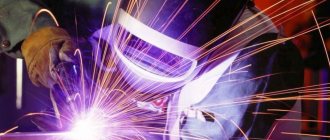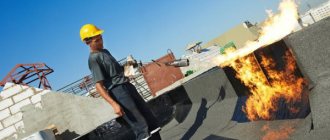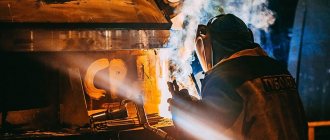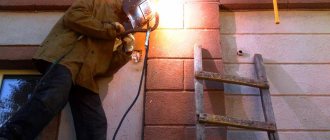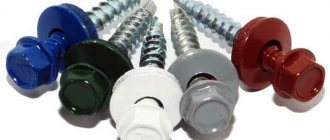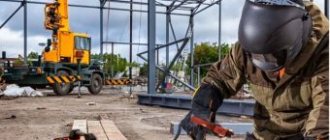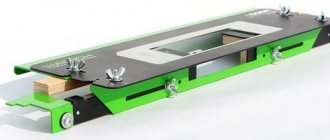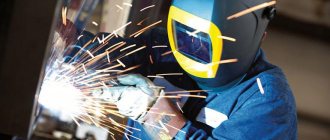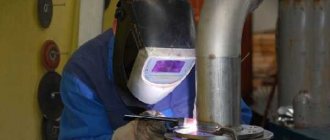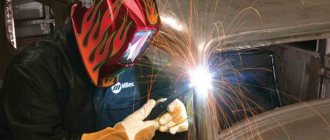Welding at height is considered to be work at a distance of 1.5 m from the ground. It can be carried out both with the help of ladders, scaffolding, aerial platforms and cradles, and with the use of equipment for industrial mountaineering. The latter method is becoming increasingly popular in large cities where work is carried out at high altitudes. Their help is sought when installing lightning rods, billboards and other structures located at heights beyond the reach of special construction equipment.
GENERAL OCCUPATIONAL SAFETY REQUIREMENTS
1.1. This Instruction provides basic labor protection requirements when working on an inverter welding machine for electric arc welding (hereinafter referred to as the welding machine). 1.2. When working on a welding machine, you must perform your duties in accordance with the requirements of these Instructions. 1.3. Persons at least 18 years of age who have passed a mandatory preliminary medical examination in accordance with the order of the Ministry of Health and Social Development of Russia dated April 12, 2011 No. 302n (Appendix No. 1, clause 1.1.4.8 (Welding aerosols), clause 3.3 (Ultraviolet radiation) are allowed to work on a welding machine ), introductory and initial workplace safety briefings, training in safe methods and techniques for performing work, on-the-job training and testing of knowledge in the prescribed manner and having received permission to work independently. 1.4. When working on a welding machine, the employee must undergo training in labor protection in the form of: introductory briefing, initial briefing at the workplace, repeated briefing, unscheduled briefing, targeted briefing and special training within the scope of the training program for the profession, including labor protection issues and requirements of job responsibilities in the profession. 1.5. Introductory briefing is carried out by a service employee labor protection or the employee replacing him, with all those hired under a program approved by the employer and agreed upon with the trade union committee or other representative body of workers. 1.6. Initial briefing at the workplace is carried out by an official determined by order individually before the start of the employee’s production activities under the occupational safety program for the profession. 1.7. Repeated instruction is carried out according to the initial instruction program once every six months by the immediate supervisor of the work individually or with a group of workers of similar professions, including combined work. 1.8. Unscheduled briefing is carried out by the immediate supervisor of work when there is a change in instructions on labor protection, technological process, technological equipment, at the request of supervisory authorities, etc., which determine the scope and content of the briefing. 1.9. Targeted instruction is carried out by the immediate supervisor when performing one-time work that is not related to the direct responsibilities of the employee by profession. 1.10. Before being allowed to work independently, an employee must undergo an internship under the supervision of an experienced worker (for 3-14 shifts, depending on length of service, experience and the nature of the work). 1.11. When working on a welding machine, a worker may be exposed to dangerous and harmful production factors: - a dangerous level of voltage in the electrical circuit, the closure of which can occur through the human body; — increased level of electromagnetic radiation (pulse); — increased content of harmful vapors and aerosols in the air of the working area; — intense radiation from the welding arc in the optical range (ultraviolet, visible, infrared); — intense thermal (infrared) radiation of welded products; — sparks, splashes and emissions of molten metal and slag; — increased surface temperature of equipment, workpieces and parts; — increased noise level in the workplace; — increased level of local vibration; — sharp edges, burrs and roughness on the surface of workpieces, equipment parts and tools; — flying fragments from the working parts of the equipment in case of their possible destruction, deformable material and scale; — insufficient illumination of the working area; — static load on the shoulder girdle; — physical overload; - fire and explosion hazard. 1.12. Sources of harmful and dangerous production factors: - faulty production equipment or its improper operation; — faulty electrical equipment or improper operation; — sharp edges, burrs and roughness on the surface of equipment and tools; — absence, malfunction, improper use of personal protective equipment; — absence, malfunction, improper operation of lighting devices; — non-fulfillment or improper fulfillment by an employee of a job description, labor protection instructions, internal labor regulations, local regulations regulating the procedure for organizing labor protection work, and working conditions at the site. 1.13. When working on a welding machine, the employee notifies his immediate supervisor about any situation that threatens the life and health of people, about every accident that occurs at work, about a deterioration in his health, including the manifestation of signs of an acute disease. 1.14. When working on a welding machine, the employee is provided with special clothing, safety shoes and personal protective equipment in accordance with current standards. 1.15. Issued special clothing, special shoes and personal protective equipment must correspond to the nature and conditions of work, ensure labor safety, and have a certificate of conformity. 1.16. Personal protective equipment for which there is no technical documentation is not allowed for use. 1.17. Personal clothing and workwear must be stored separately in lockers and a dressing room. It is prohibited to take protective clothing outside the enterprise. 1.18. When working on a welding machine, the employee should: - perform work that is part of his duties or assigned by the administration, provided that he is trained in the rules for the safe performance of this work; — strictly follow the operating rules of the welding machine established by the manufacturer; — correctly use workwear, safety shoes and other personal protective equipment (gloves, protective mask, welding helmet, earplugs, etc.); - be attentive, do not be distracted by extraneous matters and conversations; — when working together, coordinate your actions with the actions of other workers; — having noticed a violation of labor protection requirements by another employee, warn him about the need to comply with them; - keep the workplace tidy and clean throughout the working day, avoid cluttering the approaches to the workplace, use only designated passages; — know and strictly comply with the requirements of labor protection, fire safety, industrial sanitation, Rules for the technical operation of consumer electrical installations; — comply with the requirements of this Instruction, other local regulations on labor protection, fire safety, industrial sanitation, regulating working conditions and the procedure for organizing work at a specific facility; — timely and accurately comply with internal labor regulations, observe labor discipline, work and rest regime; - observe the established working hours, regulated breaks in work; - strictly carry out, within the established time frame, the orders and instructions of the enterprise management, officials responsible for the implementation of production control, as well as instructions of representatives of state supervisory authorities; — apply safe work practices; - treat the employer’s property with care; - be able to provide first aid to victims, use fire extinguishing equipment in the event of a fire, call the fire department. 1.19. Smoking and eating are permitted only in areas specially designated for this purpose. 1.20. Persons who violate the requirements of this instruction may be held accountable in the manner prescribed by the legislation of the Russian Federation.
Respiratory protection
respiratory protection filters
Damage to the respiratory system by harmful and poisonous gases is a factor that arises when working in enclosed spaces and when working with materials coated with toxic substances or causing difficulty breathing (mainly during repairs and gas cutting of used containers). Chameleon masks have proven themselves well - masks with asf with the possibility of supplying filtered air. Air filtration, thanks to the use of polyethersulfone filtration units in replaceable cartridges, has been achieved almost 100%. These masks are also useful to use when working in conditions of elevated temperatures. Forced air circulation helps cool your face and prevents the glass from fogging up.
OCCUPATIONAL SAFETY REQUIREMENTS BEFORE STARTING WORK
2.1. Check the availability and serviceability of personal protective equipment, put on them and the required protective clothing and safety shoes, and put everything in order. 2.2. Overalls must be fireproof, dry, clean, without pockets, trousers - without cuffs, safety shoes - with insulating soles and iron toes. 2.3. Fasten the overalls with all the buttons, avoiding hanging ends of the clothing, tuck your hair under your headdress, and lower your trousers over your shoes. 2.4. Do not pin your clothes with pins or needles, do not keep sharp, breakable objects in your pockets. 2.5. Receive an assignment from the manager to perform work with the welding machine and instructions on the conditions for its implementation. 2.6. Place the device on a flat surface and take measures to prevent it from tipping over. 2.7. Carry out an external inspection of the device and ensure the serviceability (integrity) of its main elements: housing, network cables, electrode holder, terminals, etc. 2.8. Prepare the welding machine for operation, connect the necessary cables and other equipment in accordance with the manufacturer’s operating instructions. 2.9. Connect the welding machine to the network. The connection must be made by an employee with an electrical safety group of at least III. 2.10. When connecting equipment, grounding should be done in accordance with the Rules for the Technical Operation of Consumer Electrical Installations. 2.11. Check the availability and suitability of welding electrodes and their sufficient quantity. 2.12. Install the electrode into the electrode holder, first making sure that the power source is turned off. 2.13. Check the operation of local exhaust ventilation. Ventilation should be turned on at least 5 minutes before starting work. 2.14. Check the availability and serviceability (integrity) of tools, equipment, and necessary accessories. Convenient to place them. 2.15. Prepare the protective equipment and devices necessary to perform the work. 2.16. Prepare the workplace for safe work: - inspect it, remove all unnecessary objects without blocking the passages; — check approaches to the workplace and evacuation routes for compliance with labor protection requirements; — check the presence and serviceability of fences and safety devices; — check the presence of signaling devices; — remove all flammable objects and materials from the welding area; — check the availability of fire-fighting equipment and first aid kits; — establish the sequence of operations. 2.17. Check by external inspection: - absence of hanging bare wires; — sufficient lighting of the workplace; — reliability of closing of all current-carrying and starting devices of the equipment; — presence and reliability of grounding connections (no breaks, strength of contact between metal non-current-carrying parts of the equipment and the grounding wire); — absence of foreign objects around the equipment; — condition of the floors (no potholes, uneven surfaces, oil stains, etc.). If the floor is slippery, it must be wiped or sprinkled with sawdust. 2.18. Carry out a test run of the welding machine, making sure that all its components are working properly and that the welding cycle can be adjusted. 2.19. Report all detected malfunctions of equipment, inventory, electrical wiring and other problems to your immediate supervisor and begin work only after they have been eliminated. 2.20. Work on the welding machine must be organized in accordance with the requirements of current technological documents (norms, instructions, regulations) approved in the prescribed manner. 2.21. It is prohibited to start working on a welding machine if there are the following violations of labor protection requirements: - the absence or malfunction of the protective shield, welding wires, electrode holder, as well as personal protective equipment; — absence or malfunction of grounding of the welding transformer housing, secondary winding, welded part and switch casing; — insufficient lighting of workplaces and approaches to them; — absence of fences for workplaces located at heights and equipped access systems to them; — fire and explosion hazardous conditions; — lack of exhaust ventilation when working in enclosed spaces.
Eye protection when welding
welder mask with asf
The impact of electric arc radiation on the organs of vision is one of the most dangerous factors faced by a welding manufacturer.
When performing particularly complex work, an assistant is required, who can also suffer retinal damage. Therefore, it is necessary for both the welder and the assistant to provide reliable protection against eye burns from the electronic arc.
The most reliable way to protect your eyes are welder masks, protective shields and welder glasses. Masks are one of the most reliable and common means of protection. Either it will be a chameleon mask (which is convenient to customize “to suit you”), or it will be a simple mask - the choice is yours, but an eye protective device is a necessity that you will encounter even before starting work.
Your assistant will also be exposed to the welding arc's eyes. In most cases, his help is necessary in preparing the material to be welded and “fixing” it at the welding site. For these works, the use of safety glasses is sufficient.
OCCUPATIONAL SAFETY REQUIREMENTS DURING WORK
3.1. Perform only the work for which you have been trained, instructed on labor protection and approved by the employee responsible for the safe performance of work. 3.2. Do not allow untrained or unauthorized persons to perform your work. Remove personnel not involved in the technological process from the workplace. 3.3. Use serviceable equipment, tools, and devices necessary for safe work; use them only for the work for which they are intended. 3.4. Monitor the operation of the welding machine and periodically carry out visual inspections. 3.5. If faulty equipment, fixtures, fittings, tools, or other violations of labor protection requirements are detected that cannot be eliminated on their own, and a threat to health, personal or collective safety arises, the employee should report this to management. Do not begin work until identified violations are eliminated. 3.6. On faulty equipment, the power supply system must be turned off and a poster prohibiting operation must be posted. 3.7. When working on a welding machine, follow the rules of its operation in accordance with the labor protection instructions. 3.8. Correctly perform the techniques of welding and other types of work: - securely fasten the surface to be treated, if necessary, first cleaning it from dirt, paint, rust, scale, etc.; — set the welding current depending on the properties of the surface being processed (material, thickness, etc.); - before performing the actual operation, carry out a trial operation on another similar surface, adjust the established parameters; — when performing work, use only high-quality electrodes; — perform the corresponding manipulations with the tool at approximately an angle of 45° to the surface being processed; — avoid direct contact with the electrical welding circuit; — when welding small parts, make sure that your hands are not pressed by the working electrode; — when changing electrodes, throw the cinders into a metal box; — during short breaks in work, hang the electrode holder on a special stand; — at least twice a shift, completely clean the welding circuit from burrs, splashes of molten metal, oxides, scale, etc. Carry out all adjustment work only with the switch turned off; — periodically clean the inverter housing from dirt and dust. 3.9. When working on a welding machine, it is PROHIBITED: - connect more than one welding transformer or other current consumer to one switch; — carry out repairs of electric welding installations that are under voltage; — weld freshly painted structures, devices and communications, as well as structures, devices and communications that are under pressure, electrical voltage, filled with flammable, toxic materials, liquids, gases, vapors; - welding and cutting containers containing flammable and flammable liquids, as well as flammable and explosive gases (tanks, tanks, barrels, reservoirs) without preliminary cleaning, steaming these containers and removing gases by ventilation; — use grounding wires, sanitary pipes (water supply, gas pipeline, ventilation), metal structures of buildings and technological equipment as an electric welding return wire; - use personal protective equipment made of synthetic materials that do not have protective properties, are destroyed by the influence of the welding arc and can ignite from sparks and splashes of molten metal, and sinter upon contact with heated surfaces; — during breaks in work and at the end of work, leave electric welding tools under electric voltage at the workplace; — operate equipment under overload; — connect the device to a network with a voltage greater than the permitted one; — use metal building structures of buildings, communications and non-welding technological equipment as the return wire of the grounding network; — switch operating modes, disconnect any of the cables during the welding process; - work with damaged or poorly connected cables or worn cable clamps; - carry out work on containers, tanks or pipes that contain liquid or gaseous flammable substances, chlorine-containing liquids; — carry out work on pressure tanks; — touch live parts with bare hands; — turn on the device if any of its protective parts have been removed; — lean close to the welding area; - look at the arc without using eye protection; — carry out work wearing wet gloves, as well as using faulty personal protective equipment; - work in rooms with high humidity levels; — allow cables to come into contact with water, as well as splashes of molten metal; — allow water to get inside the device; - weld metal covered with dirt, paint, oil, rust or a thick layer of scale, without first cleaning it; — touch with your hands to check electrodes, welding points, etc.; — carry out cleaning and cleaning of equipment during its operation; — leave the equipment turned on after completing work; — place flammable and flammable materials at a distance of less than 5 m from welding operations; - work with equipment under the influence of alcohol, drugs, medications.
Results
NPs are sufficiently detailed in terms of implementation of occupational health and safety measures by responsible persons and bring the requirements closer to SNiPs in terms of many work options. This should increase the level of labor protection and injury prevention. NP is recommended to be applied taking into account SNiP where it is appropriate and should increase the level of occupational health and safety.
Work at height is usually associated with construction.
For the latter, special labor protection rules have also been established. You can find more complete information on the topic in ConsultantPlus. Free trial access to the system for 2 days.
OCCUPATIONAL SAFETY REQUIREMENTS IN EMERGENCIES
4.1. If a breakdown of the welding machine occurs (violation of the integrity of the cables, protective grounding of the housing, etc.), threatening an accident at the workplace or in the workshop: - stop its operation, as well as the supply of electricity to it, etc. Do not fix the problem yourself; — report on the measures taken to the immediate supervisor (the person responsible for the safe operation of the equipment); - act in accordance with the instructions received. 4.2. In an emergency: - notify surrounding people of the danger; — report to your immediate supervisor about the incident; — act in accordance with the emergency response plan. 4.3. If a fire appears, you must: — stop work; — disconnect the device and other electrical equipment from the network, turn off the ventilation; — organize the evacuation of people; - Start extinguishing the fire immediately. 4.4. When electrical equipment catches fire, only carbon dioxide or powder fire extinguishers should be used. 4.5. If it is impossible to extinguish the fire on their own, the employee should call the fire brigade in the prescribed manner by calling 101 and inform the immediate supervisor or management of the enterprise. 4.6. In case of injury or deterioration of health, the employee must stop work, notify management and call an ambulance by calling 103. 4.7. If an accident occurs and an employee witnesses it, he should: - stop working; — immediately report the incident to your immediate supervisor; — immediately remove or carry the victim out of the danger zone; - provide first aid to the victim, - call an ambulance by calling 103; — help organize the delivery of the victim to the nearest medical facility. 4.8. When assisting a victim with broken bones, bruises, or sprains, it is necessary to ensure the immobility of the damaged part of the body by applying a tight bandage (splint) and applying cold. For open fractures, you must first apply a bandage and only then a splint. 4.9. If there are wounds, apply a bandage; if there is arterial bleeding, apply a tourniquet. 4.10. In case of electric shock, it is necessary to stop exposing the victim to electric current. This can be achieved by disconnecting the current source, breaking the supply wires, the switch, or diverting the source of influence from the victim. This must be done with a dry rope, stick, etc. 4.11. Do not touch a victim who is under the influence of current with your hands; — call a doctor or city ambulance; - examine the victim. External damage must be treated and covered with a bandage; - in the absence of a pulse, perform an indirect cardiac massage and perform artificial respiration. 4.12. Measures must be taken until body functions are restored or signs of death appear. 4.13. For burns: - without violating the integrity of the burn blisters, it is necessary to place the affected area of skin under a stream of cold water for 10-15 minutes or apply cold water to it for 20-30 minutes. Do not lubricate the burned surface with oils and fats; - if the integrity of the burn blisters is damaged, it is necessary to cover the affected area of skin with a dry, clean cloth and apply cold air over it. Do not rinse with water or bandage the burned surface. 4.14. If you are poisoned by harmful vapors and aerosols, you must leave the room and go into fresh air. 4.15. When investigating the circumstances and causes of an accident, the employee should provide the commission with information known to him about the accident that occurred.
Protection against welding spatter
Burns when working with welding equipment can be obtained not only during flame cutting or welding, but also when working with simple electric arc welding.
welder overalls
Often, novice, inexperienced welders pay little attention to special clothing. But there are many cases of burning and even fire from a drop of molten metal formed during welding. Gaiters are used to protect hands. To protect the body - fireproof jackets, trousers, suits. The most effective is overalls. Special welder's boots are used for the feet. Clothes and shoes must be tailored to fit. You should feel comfortable in it - the productivity and efficiency of your work depends on it.
Safety precautions when welding at height
Work in rooms where large-scale structures are assembled and work at height have an increased risk of injury.
helmet mask
When performing them, it is necessary to use a special mask used together with a protective helmet. To work safely at height, it is necessary to use a protective belt, which provides the possibility of reliable safety fastening to the structure; boots should not have metal parts.
OCCUPATIONAL SAFETY REQUIREMENTS AFTER WORK COMPLETION
5.1. Disconnect the welding machine from the network, turn off the ventilation. 5.2. Disconnect cables. 5.3. Inspect and tidy up the workplace. 5.4. Clean the surfaces of the device and inspect its elements and components for damage. 5.5. Place the semi-automatic welding machine in a specially designated well-ventilated place. 5.6. Take off your overalls. Contaminated workwear must be washed. 5.7. Wash your hands and face thoroughly with soap or take a shower. 5.8. Report to the management of the organization about all violations of the production process, labor protection requirements, and cases of injuries at work.
Safety precautions for gas welding
The danger of working with gas-cylinder equipment is very high. Beginners need to carry out all work under the supervision of an experienced worker before acquiring the necessary qualifications and experience.
- All equipment must be of industrial production and undergo periodic inspection.
- Before starting work, make sure that the gas cylinder equipment is in good working order, and ensure that the gas cylinders are not exposed to direct sunlight.
- Do not allow engine oil to come into contact with oxygen cylinders.
- Determine a place to store gas welding equipment and prevent unauthorized persons from accessing it.
- It is most convenient to store gas cylinders in special cabinets.
metal cabinet for gas cylinder
In conclusion, I would like to note that all of the activities listed above in 5 parts are not fully covered, but they give beginners an idea of the dangers of welding work and the necessary protective measures. Before starting work, study the necessary literature on safety measures and consult with specialists.
